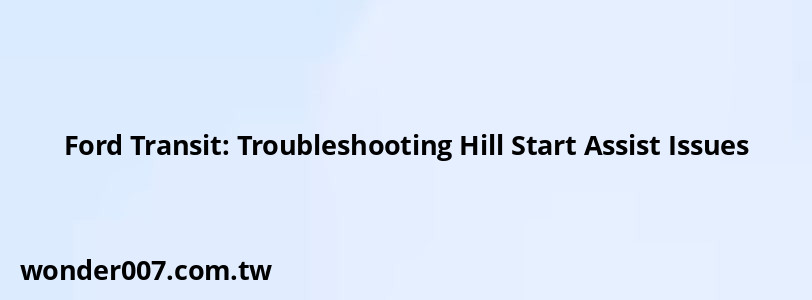Ford Transit: Troubleshooting Hill Start Assist Issues

Experiencing the "Hill Start Assist Not Available" warning in your Ford Transit can be concerning, especially for drivers who frequently navigate hilly terrains. This feature is designed to prevent rollback when starting on an incline, making it crucial for safe driving. Understanding the common causes and solutions can help you address this issue effectively.
Understanding Hill Start Assist
Hill Start Assist is an advanced feature that temporarily holds brake pressure when the vehicle is on an incline. This allows the driver enough time to transition from the brake to the accelerator without rolling backward. If this system becomes unavailable, it can lead to potential safety risks.
Common Causes of Hill Start Assist Malfunction
Several factors can trigger the "Hill Start Assist Not Available" warning:
- Low Battery Voltage: Insufficient power can disable electronic systems, including Hill Start Assist. A healthy battery should read around 12.6 volts.
- Faulty Wheel Speed Sensors: These sensors are essential for the proper functioning of various safety features, including Hill Start Assist. Damage or debris can impair their performance.
- Brake System Issues: Problems such as low brake fluid, worn brake pads, or malfunctioning brake lights can affect the system's operation.
- Software Glitches: Updates or errors in the vehicle's software may disrupt normal functionality.
- Problems with ABS or Traction Control: If these systems are disabled, it can impact Hill Start Assist as well.
Diagnosing the Problem
To identify the root cause of the issue, consider the following steps:
- Check for Other Warning Lights: Look for additional dashboard warnings that could indicate broader issues.
- Use an OBD-II Scanner: Reading error codes can provide insights into specific problems affecting your vehicle.
- Inspect Brake Lights: Ensure that all brake lights function correctly, as they are linked to the Hill Start Assist feature.
- Test Battery Health: Use a multimeter to confirm that your battery is delivering adequate voltage.
Solutions to Reactivate Hill Start Assist
Here are some recommended steps to resolve the issue:
1. Reset the System
- Turn off the engine and wait a few minutes before restarting. This simple step can sometimes clear temporary errors in electronic systems.
2. Check and Replace Sensors
- Inspect wheel speed sensors for any signs of damage or obstruction. Replace any faulty sensors as necessary.
3. Address Battery Issues
- If your battery is low, charge it fully or consider replacing it if it's old or failing.
4. Repair Brake System
- Check brake fluid levels and inspect brake pads and rotors for wear. Replace any worn components to restore functionality.
5. Update Software
- Visit a Ford dealership to check for available software updates that may resolve underlying issues affecting Hill Start Assist.
6. Professional Diagnosis
If troubleshooting does not resolve the warning, consult a certified mechanic for a comprehensive diagnostic test to address complex issues related to ABS or ESC systems.
Preventive Measures
To avoid future issues with Hill Start Assist:
- Regularly service your Ford Transit to maintain optimal performance.
- Keep an eye on battery health and address any dashboard warning lights promptly.
- Ensure that wheel speed sensors remain clean and functional.
FAQs About Ford Transit Hill Assist
- Can I drive with Hill Start Assist unavailable?
Yes, but exercise caution on inclines and consider addressing the issue promptly. - How much does it cost to fix Hill Start Assist?
Costs vary depending on the cause, ranging from a simple reset (free) to sensor replacement ($100-$300) or more complex repairs. - Will a dead battery cause Hill Start Assist to fail?
Yes, low or dead batteries can disable this system. - What should I do if my clutch pedal is sticking?
Lubricate the clutch pedal with a product like WD40 to prevent sticking.
By understanding these common causes and solutions, you can take proactive steps to ensure your Ford Transit remains reliable and safe while driving on inclines.
Related Posts
-
2001 VW Cabrio Cranking But Not Starting: Fix Guide
26-01-2025 • 158 views -
Chevy TBI Running Rich: Troubleshooting Guide
27-01-2025 • 195 views -
Chevy Equinox: Troubleshooting Starting Issues After Battery Replacement
27-01-2025 • 227 views -
Dodge Ram 4x4 Vacuum Diagram: Troubleshooting Guide
29-01-2025 • 144 views -
Blind Spot Light Stays On: Troubleshooting Tips and Solutions
26-01-2025 • 224 views
Latest Posts
-
How To Turn Off Paddle Shifters Mercedes
01-02-2025 • 377 views -
Are O2 Sensors Covered Under Warranty
01-02-2025 • 376 views -
Rear Brake Caliper Piston Won't Compress
01-02-2025 • 356 views -
2015 Chevy Traverse AC Recharge Port Location
01-02-2025 • 409 views -
Power Steering Fluid Leak On Passenger Side
01-02-2025 • 457 views
Popular Posts
-
V12 Engine Costs: What You Need to Know
26-01-2025 • 679 views -
EPC Warning Light: What It Means for Your Vehicle
27-01-2025 • 630 views -
Power Steering and ABS Light On: Causes and Solutions
27-01-2025 • 643 views -
Hino Warning Lights: Understanding Dashboard Alerts
26-01-2025 • 765 views -
EPC Light: Understanding Causes and Solutions
26-01-2025 • 1053 views
